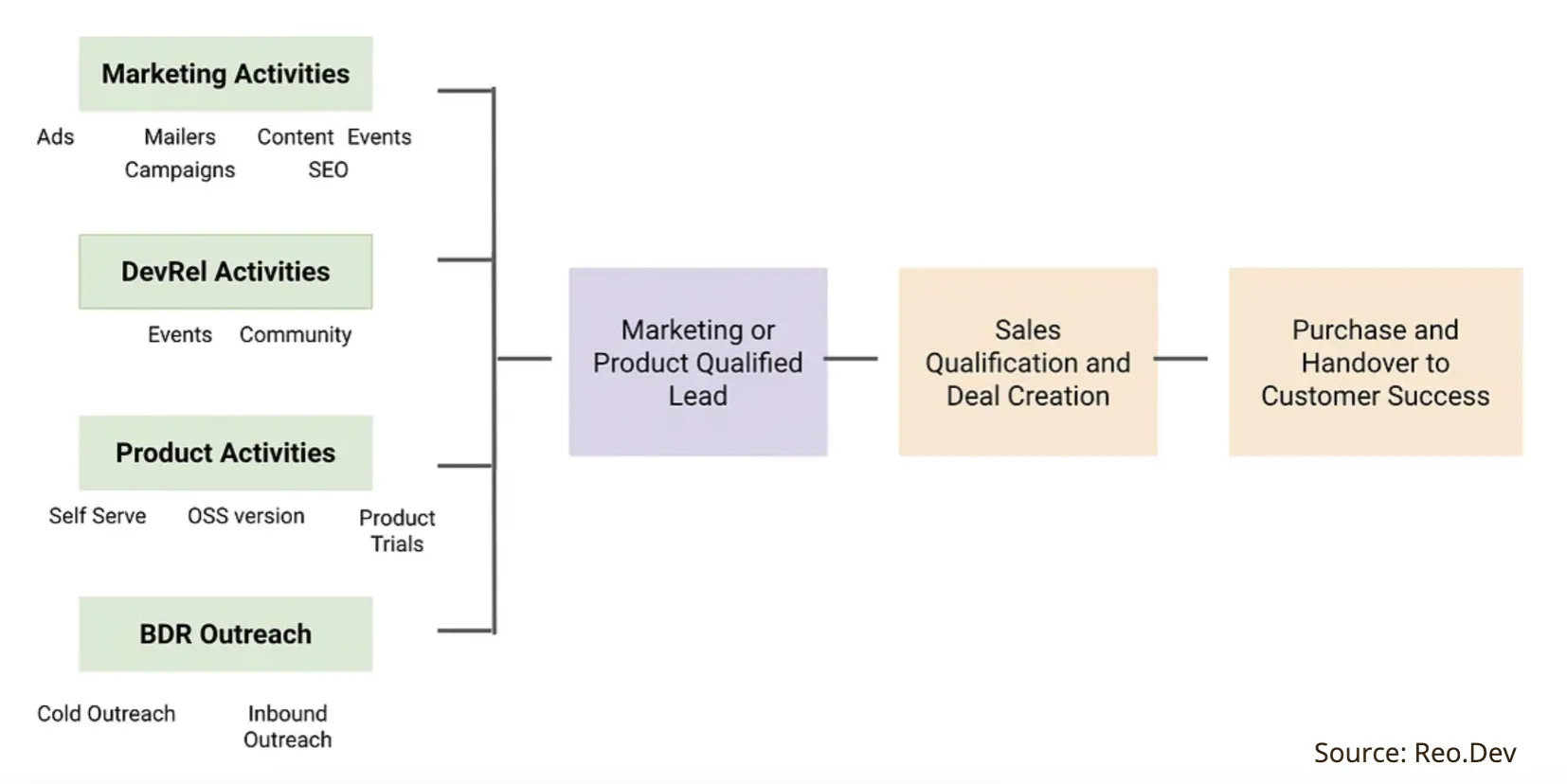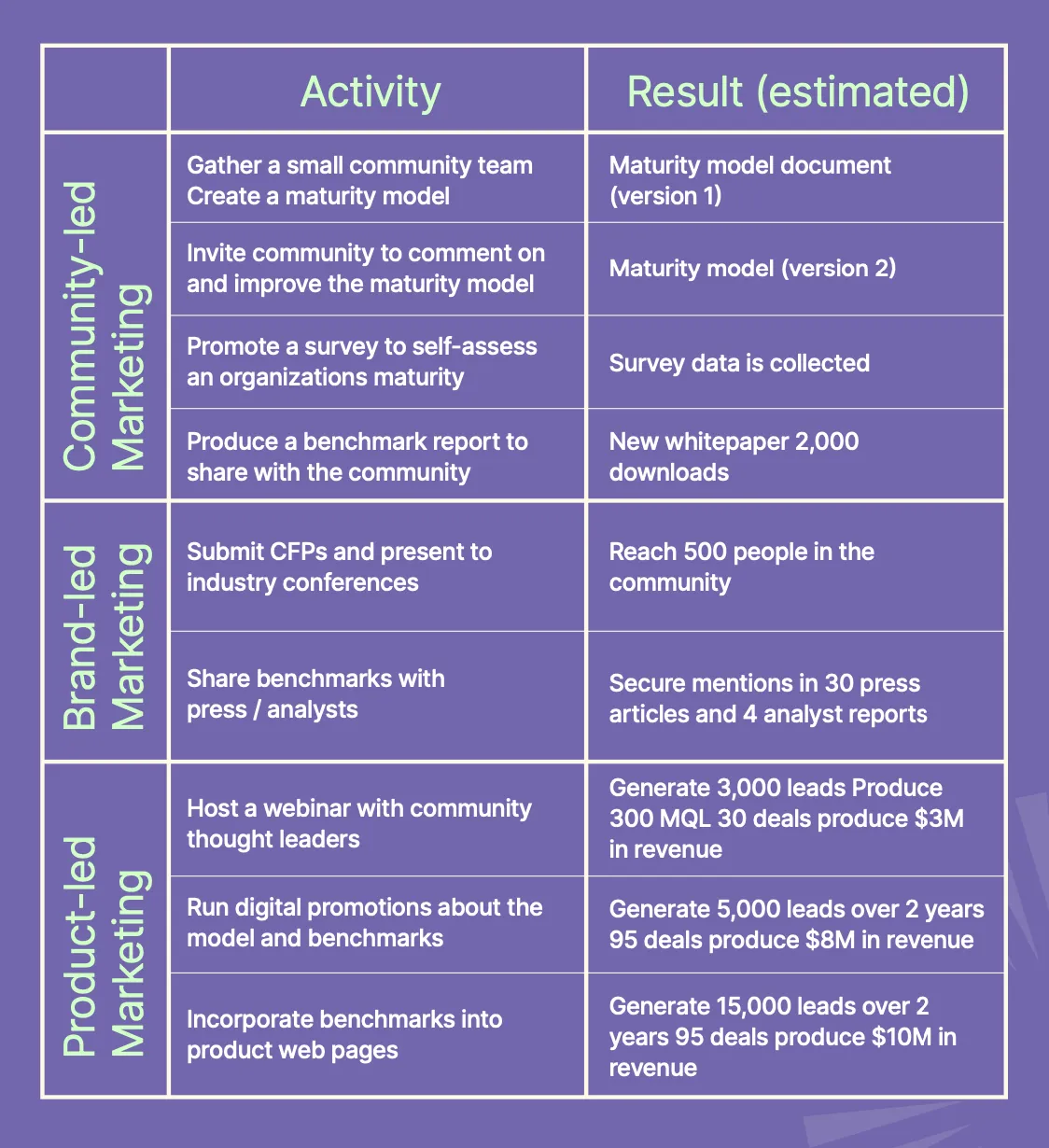
From Leads to Wins: Crafting a DevOps GTM That Scales with Sales and Product
For DevOps companies, mastering and scaling their GTM playbook is essential for success. They often face a critical choice between two “divergent” paths: a sales-driven approach or a product-led strategy. These two options are typically viewed as mutually exclusive.
Traditional GTM Misses the Mark
This approach is often seen as a linear funnel, with lead qualification as the primary north star metric. However, it fails to account for the distinct behavior of prospects, who tend to evaluate products and make decisions simultaneously, displaying more synchronized behavior than this model assumes.
In the DevOps environment, the disconnect is exacerbated by the siloed nature of teams, which prevents cohesive action. Developer Relations (DevRel) teams, which play a crucial role in engaging with developers and understanding end-user pain points, are often key players in the product experience. However, they are typically not integrated into the sales process, despite their valuable insights and contributions. This snowballs into a huge opportunity cost for the company, because the marketing strategy adopted is the same for buyer and user, despite them being two very different personas. This lack of a tailored approach means that sales teams and account executives (AEs) often engage with prospects without the necessary context (is the prospect mature enough to buy the solution) – leading to cost inefficiencies.

Modern GTM Strategy
As we've observed, the traditional approach may be classic, but it isn't always timeless. As industries evolve, there's a pressing need for a new go-to-market strategy.
A lead is not enough: shift from lead-first to account-first approach
Traditional GTM often focuses solely on individual leads/sign-ups at the top of the funnel. However, it is crucial to understand the broader context of developer activities within each account. This calls for a shift from a lead-based approach to an account-first strategy, where developer behavior is tracked and analyzed across the organisation. By triangulating intent signals—such as patterns in product interactions, engagement in community forums, and participation in relevant tech events—teams can gain valuable insights. This allows companies to tailor their outreach and engagement strategies to address the specific needs and challenges of the entire account rather than just individual leads.
Silos do not work in any context: need for a collaborative and team-oriented execution
In a DevOps environment, it's essential for all stakeholders—marketing, sales, product, and DevRel—to maintain constant communication. For instance, DevRel can offer valuable insights into developers' pain points and preferences, the product team can highlight the solution’s capabilities, and the marketing team can surface broader market trends. By fostering collaboration between these teams, this approach ensures a more cohesive and effective strategy that aligns with the prospect's journey, from discovery to decision-making.
Integrating bottom-up and top-down approaches by being cognizant of two distinct personas
In many DevOps organisations, two distinct personas influence the purchasing decision: the user (a developer or technical team) and the buyer (a manager or executive). Addressing the needs of both requires a dual approach:
- Bottom-up: This strategy centers on educating users through product-led initiatives, community engagement, and hands-on experiences. It involves creating comprehensive content such as tutorials and workshops, where users can actively engage with both the community and the product. Beyond marketing, this strategy is vital for gathering valuable product feedback directly from the user base.
- Top-down: This strategy focuses on the buyer persona who prefer more broader and high-level engagement. This would involve how the product fits the broader scope of the organisation and the ROI attached to it. This is important wherein the ticket size is large and the buyer would need to justify the commercials internally.

A modern go-to-market strategy aligns both Sales-Led Growth (SLG) and Product-Led Growth (PLG) while addressing both enterprise and SMB to mid-market segments. It's crucial to establish this alignment early in the journey, rather than waiting to shift upstream later. Focus on moving upstream from day one—or better yet, from day zero—to ensure long-term scalability and success.
Levers of Cracking Modern GTM
1. Community Flywheel
a) Identify community-market fit
Define the purpose of the community
- It is crucial to define the core purpose of the community. Is it to focus on user support, catalyze product feedback, establish leadership?
- Ensure that the community's purpose aligns with two key factors: the company’s long-term vision and the needs of the target audience. At the cusp of these two elements defines the true purpose of the community
Identify the target audience
- Basis the purpose, one can identify whether the community is meant to service existing user base or a sub-sect of the larger user base or attract new users
- The identified members will have unique characteristics which will further nuance how the community can add the most value
Broaden the community’s scope
- The community should offer value that extends beyond the company’s products or services. It's essential that the community prioritizes serving its users first, the company’s goal follows
- Ensure that the community addresses broader industry trends and challenges to make it a go-to place for its members.This could include industry-wide discussions, offering educational resources and/or creating wider networking opportunities
b) Setup user database, create and analyse segments
- Segment Community Members: Once data is consolidated, segment community members based on factors such as role, product usage, geographic location, and level of engagement.
- Tailored Engagement and Marketing: Plan engagement and marketing strategies according to these segments, aligning activities with the specific interests and needs of each group.
- Map User Journeys: Track user journeys from initial awareness through deeper engagement, leading to lead qualification. Understand how the community interacted with users at various stages of their journey.
- Nurture Leads Post-Qualification: Rather than stopping community efforts after a lead is qualified, continue nurturing them through personalised, community-driven content and activities. This could include targeted webinars, exclusive content, or personalised follow-ups based on their engagement history.
c) Defining ROI & Attribution
It is important to be cognizant that community attribution is not about instant gratification, the community serves as a base that the company can tap into over a course of time
Content-Based Lead Generation:
- Community engagement and activities can generate valuable content (example a survey) for top-of-funnel efforts, which can be leveraged for lead generation. Additionally, this content (say output of the survey) can be repurposed for middle-of-funnel strategies, eventually transitioning prospects to marketing and sales for conversion
Account-Based Lead Generation:
- Track Community Investments: Quarterly reports from the CMO should monitor investments in community events, the number of top-of-funnel leads generated, and the percentage of those leads that match target segments and lead qualification criteria, ultimately converting into sales opportunities
- Align with ABM Strategies: Ensure community participation aligns with account-based marketing (ABM) by tracking how many individuals from target accounts are engaging in community events
- Analyse Deal Velocity: Use data to assess how quickly deals with target accounts are closed due to community involvement, incorporating feedback from the sales team for insights.

2. Building vs Leveraging Existing Communities
Smaller companies often face significant challenges in maintaining a thriving community due to limited resources and budget constraints. Building and sustaining an active, engaged community requires consistent effort and investment, which can be difficult for businesses with tighter budgets. In the case of larger companies, allocating a portion of the marketing budget (typically 5-10%) to community-led efforts can be a highly effective strategy. However, it’s essential to balance these efforts with traditional marketing approaches to ensure overall brand growth and revenue generation. Community efforts should complement rather than replace traditional marketing, creating a holistic strategy that leverages the strengths of both approaches.
For smaller companies, building a community from scratch can be daunting. Instead, a more viable approach is to engage with existing communities relevant to your industry. Aim to contribute meaningfully by dedicating time and resources—ideally around 1K hours per year—to become an active participant. The key focus should be:
- Establishing influence and thought leadership within the community is essential. This involves not only initiating discussions and contributing to the community’s direction but also identifying unmet needs and gaps that are less obvious.
- Addressing gaps and launching parallel communities can be highly valuable. These gaps can be used to form a new community or enhance the product. This will help the company establish a niche within a sub-sect and essentially create a hook.
- Leverage Key Opinion Leaders (KOLs) and influencers to generate a higher signal to noise ratio. Many developer tools companies focus on targeting Key Opinion Leaders (KOLs) or influential developers within their space. These influencers can be instrumental in driving community engagement and adoption of your product.
3. Content
Content is the backbone of community-driven initiatives. This involves
- Monitoring and analysing content across platforms like your website, LinkedIn, Medium, Substack, and HackerNews offers valuable insights into what’s working for your company and what topics and formats resonate with your target audience. Tools like BuzzSumo can help identify high-performing content in your industry.
- As part of building thought leadership, it's crucial for early-stage companies to engage on Q&A platforms like Stack Overflow, Reddit, and HackerNews. Active participation by the founding team will strengthen the company’s presence and position it as a leader in the industry
- Hosting events boosts both content and the broader community. For early-stage companies, it's crucial to understand the target audience and choose speakers who offer valuable tangible insights. HashiCorp utilises Twitch to host regular development streams, engaging both current and potential users. This approach allows them to provide real-time demonstrations and interact with their community, showcasing their expertise and keeping their audience informed and engaged.
Example | Sonatype
The company provides comprehensive software supply chain security solutions for enterprises. The platform enables both speed and security in open-source development. Sonatype harnessed a community-led GTM strategy to expand its global reach. They launched a conference and built a global DevOps community, intentionally avoiding a regional focus. The event centered on providing education beyond the scope of their product, ensuring high-quality content by prohibiting vendor pitches.
Sonatype utilised their global community conference to generate a wealth of SEO-rich content, created organically by the community, which helped drive ongoing engagement and visibility. They made this content freely accessible to their global audience. By converting conference talks into blog posts and compiling them into published books, Sonatype created a continuous content cycle that kept the community engaged and attracted new members. These books were also featured at industry events and book signings, enhancing brand visibility and seamlessly integrating community-driven efforts into traditional demand generation strategies.
This company was successful in getting the community-brand attached to the company brand.

.png)












